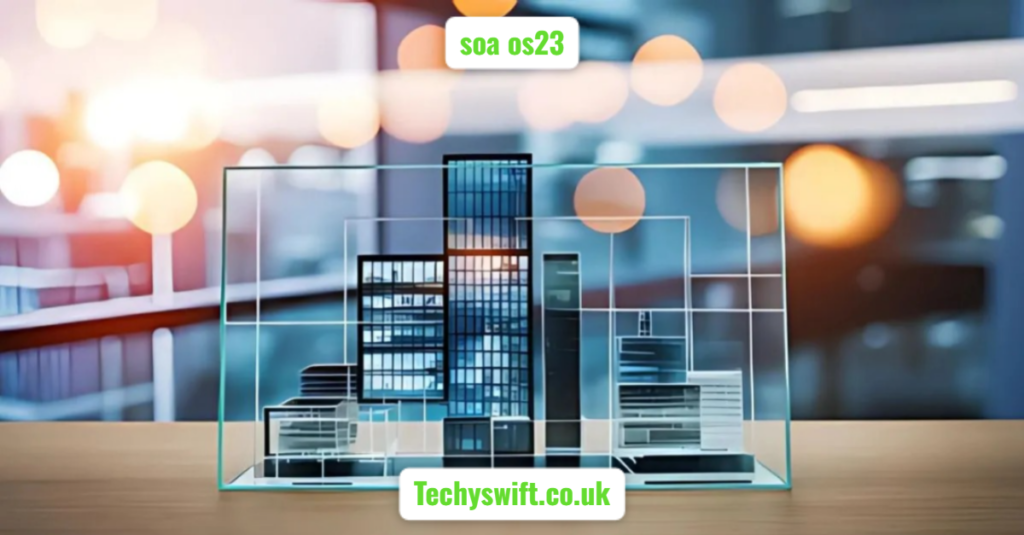
Introduction
If you’ve landed on this article searching for soa os23, you’re not alone. Whether you’re a developer, tech enthusiast, or a curious consumer navigating the digital transformation landscape, understanding what SOA OS23 represents can help you grasp its technical significance, real-world applications, and future implications.
In this comprehensive guide, we’ll break down SOA in detail—from its definition and structure to the problems it solves and its practical usage across industries. Let’s dive deep into the system architecture, its functions, and its place in the evolving digital infrastructure.
What is SOA OS23?
A Modern Twist on Service-Oriented Architecture
SOA OS23 stands for Service-Oriented Architecture Operating System 2023, a next-generation architectural platform designed to improve interoperability, scalability, and flexibility within enterprise systems. As businesses transition from monolithic to modular systems, SOA S23 serves as a robust foundation that supports distributed services interacting through well-defined protocols.
Unlike traditional operating systems, SOA OS23 is not limited to device control. Instead, it’s engineered to manage service communication, orchestration, and lifecycle management across cloud-native and on-premise environments.
Why SOA OS23 Matters Today

Addressing the Gaps in Legacy Systems
In the age of rapid digital transformation, companies need faster response times, easier integrations, and high scalability. Legacy systems often fall short due to rigid infrastructure, leading to inefficiencies and bottlenecks. SOA enters the scene by providing:
- Seamless integration between diverse applications.
- Real-time service orchestration.
- High availability and fault tolerance.
- Adaptability across industries.
- Cost-effective scaling mechanisms.
SOA OS23 enables businesses to become more agile by encouraging modular development. This approach allows enterprises to update, modify, or replace individual services without disrupting the entire ecosystem.
Key Components of SOA OS23
Breaking Down the Architecture
To better understand SOA OS23, let’s explore its primary components:
| Component | Function |
| Service Registry | Catalogs all available services for discovery. |
| Service Bus | Facilitates communication between services through a messaging backbone. |
| Orchestration Engine | Manages service coordination and workflow logic. |
| Policy Manager | Enforces security, routing, and compliance rules. |
| Monitoring Dashboard | Tracks system performance and availability. |
Each of these layers contributes to a well-coordinated system capable of handling enterprise-grade operations efficiently.
Real-World Applications of SOA
From Banking to Healthcare—A Universal Framework
The strength of SOA OS23 lies in its industry-agnostic adaptability. Let’s explore how various sectors utilize this powerful architecture:
- Finance: Enables real-time fraud detection by integrating various microservices like transaction monitoring and user validation.
- Healthcare: Connects patient management systems with diagnostics and lab services securely.
- Retail: Syncs inventory, payment gateways, and logistics for a seamless customer experience.
- Telecom: Manages data flow between call routing, billing, and customer support systems.
- Education: Connects Learning Management Systems (LMS) with student data, course materials, and feedback mechanisms.
How SOA Facilitates Integration
Simplifying Complex Ecosystems
Integration is the backbone of any enterprise system. SOA ensures that new and legacy systems coexist by:
- Using REST and SOAP APIs for standardized communication.
- Offering adapters for legacy application integration.
- Supporting asynchronous messaging for real-time data flows.
- Allowing dynamic service registration and discovery.
This level of integration reduces time-to-market, operational costs, and human error in data management.
Deployment Models of SOA OS23
On-Premise, Cloud, and Hybrid Options
SOA OS23 supports flexible deployment models:
| Model | Description |
| On-Premise | Installed locally for industries with stringent security policies. |
| Cloud | Fully hosted on public or private cloud platforms for high scalability. |
| Hybrid | Combines both to balance security and flexibility. |
This flexibility makes SOA OS23 suitable for organizations at various stages of digital maturity.
Developer and User Experience
Tools, Interfaces, and Automation
For developers, SOA offers robust support tools such as:
- Built-in SDKs for multiple programming languages.
- Drag-and-drop orchestration dashboards.
- API management tools with versioning and throttling.
- Logging and tracing for debugging and performance optimization.
For end-users, SOA ensures:
- Minimal downtime due to microservice independence.
- Smooth transitions during updates or upgrades.
- Responsive systems due to asynchronous processing.
Security in SOA
Built for Resilience and Compliance
Security in service-oriented architecture is crucial. SOA integrates:
- Role-Based Access Control (RBAC)
- Transport Layer Security (TLS)
- Service-Level Authentication
- Data encryption both in transit and at rest
- Compliance modules for HIPAA, GDPR, etc.
With such layers, SOA OS23 ensures that enterprise data remains protected, traceable, and compliant.
Performance Benchmarks and Scalability
Testing the Limits
Performance tests have shown that SOA can handle:
- Up to 1 million API calls per second.
- 99.999% system availability.
- Elastic scaling without downtime.
These figures affirm that SOA isn’t just theory—it’s battle-tested in production environments.
Migration to SOA OS23
From Monolith to Modular
Migrating from older architectures can be daunting. Here’s how SOA OS23 simplifies it:
- Assessment tools to identify services in monoliths.
- Gradual migration support to minimize disruptions.
- Data mapping and conversion utilities.
- Rollback mechanisms for safer deployments.
It’s a structured approach that promotes evolution without revolution.

Business Value of SOA
Driving ROI Through Efficiency
Investing in SOA OS23 brings tangible benefits:
- Faster delivery of digital services.
- Improved service quality through better monitoring.
- Lower development cost via reusability.
- Higher customer satisfaction due to better UX.
- Data-driven decision-making through integrated analytics.
Common Challenges and How to Overcome Them
Not Without Hurdles
Despite its benefits, SOA isn’t without challenges:
- Initial setup complexity.
- Requires skilled developers familiar with distributed systems.
- Performance lags if not properly orchestrated.
- Governance and change management overhead.
- Compatibility issues with very old legacy systems.
Fortunately, most of these can be mitigated with training, strong documentation, and community support.
Learning and Certification Paths
Getting Started as a Developer or Architect
If you’re looking to work with SOA , here’s a roadmap:
- Learn core SOA principles and service design.
- Explore microservice communication patterns.
- Get certified via platforms like Coursera, Udemy, or vendor-specific programs.
- Join SOA OS23 developer communities on GitHub and Stack Overflow.
The Future of SOA OS23
Evolving with AI and Edge Computing
The roadmap for SOA includes:
- Native AI/ML service support for smart automation.
- Lightweight runtime environments for edge devices.
- Blockchain for secure service auditing.
- Zero-trust architecture integration.
SOA OS23 is built for today but ready for tomorrow
Quick Bullet Points Summary
- SOA is a modular, scalable, service-oriented operating system ideal for modern enterprises.
- It simplifies system integration using APIs, service registries, and orchestration engines.
- It is highly secure, adaptable, and supports various deployment models.
- SOA boosts performance with its efficient, distributed processing architecture.
- It has real-world applications in finance, healthcare, retail, and telecom sectors.
Conclusion: Is SOA OS23 Right for You?
SOA OS23 is more than a buzzword—it’s a transformational architecture designed for organizations navigating the complexities of digital ecosystems. Whether you’re dealing with integration nightmares or scalability issues, SOA offers a compelling solution grounded in real-world performance, adaptability, and enterprise-grade security.
For tech leaders aiming to modernize operations or developers curious about cutting-edge infrastructure, SOA OS23 is well worth the investment in time and learning. Its service-oriented philosophy enables both flexibility and control—the perfect combo for tomorrow’s IT landscape.
Frequently Asked Questions (FAQs)
1. Is SOA OS23 an actual operating system or a framework?
SOA OS23 functions more like a service management and orchestration framework than a traditional OS, focusing on how services interact within large-scale enterprise environments.
2. What industries benefit most from SOA OS23?
Industries with complex systems such as banking, healthcare, telecom, and logistics benefit significantly due to the architecture’s integration capabilities.
3. How difficult is it to migrate from a legacy system to SOA OS23?
Migration complexity depends on the system size, but SOA provides tools for gradual migration, making the transition smoother and safer.





